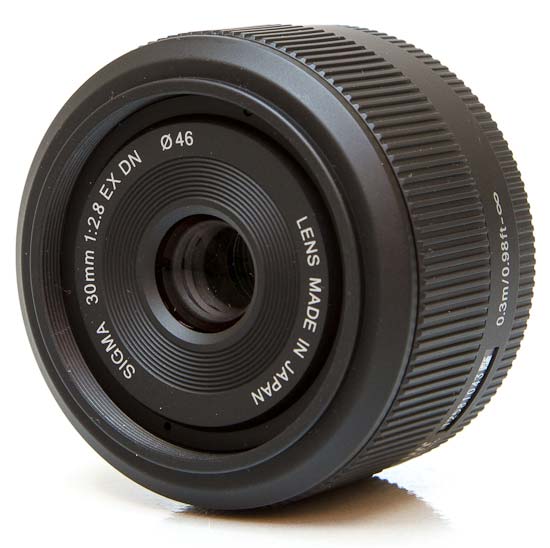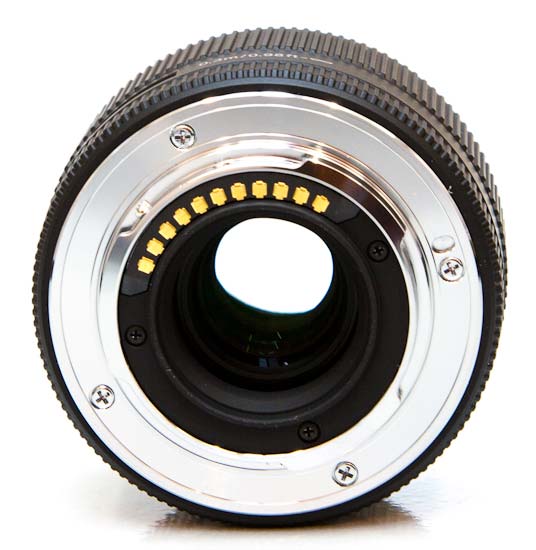Sigma 30mm f/2.8 EX DN Review

Introduction
The Sigma 30mm f/2.8 EX DN is a new affordable standard prime lens for Micro Four Thirds and Sony NEX compact system cameras. It offers the equivalent angle of view as a 60mm lens on the Micro Four Thirds system and 45mm on the E-mount sytem. The Sigma 30mm f/2.8 EX DN features a rounded 7 blade diaphragm which creates an attractive blur to the out of focus areas of the image. It has a minimum focusing distance of 30cm /11.8in and a maximum reproduction ratio of 1:8.1. A linear AF motor moves the lens units directly without the need for gears or the drive of other mechanical parts. The Sigma 30mm f/2.8 EX DN lens is currently available for £169.99 / $280 in the UK and the US, respectively.
Ease of Use
 The Sigma 30mm f/2.8 EX DN lens
The Sigma 30mm f/2.8 EX DN lens
Weighing in at a mere 135 grams, the plastic-bodied Sigma 30mm f/2.8 EX DN is very lightweight. It's smaller than the 19mm lens that Sigma launched at the same time. As seen in the photos below, it complements a mid-sized Micro Four Thirds camera like the Olympus E-PL1 very well and also doesn't look out of place on an even smaller camera like the Panasonic Lumix DMC-GF3.
 The Sigma 30mm f/2.8 EX DN lens mounted on an Olympus E-PL1
The Sigma 30mm f/2.8 EX DN lens mounted on an Olympus E-PL1
 The Sigma 30mm f/2.8 EX DN lens mounted on an Olympus E-PL1
The Sigma 30mm f/2.8 EX DN lens mounted on an Olympus E-PL1
 The Sigma 30mm f/2.8 EX DN lens mounted on an Olympus E-PL1
The Sigma 30mm f/2.8 EX DN lens mounted on an Olympus E-PL1
 The Sigma 30mm f/2.8 EX DN lens alongside an Olympus E-PL1
The Sigma 30mm f/2.8 EX DN lens alongside an Olympus E-PL1
Build quality is pretty decent for what is a consumer lens. Most of the outer parts are plastic - contributing to the light weight of the lens - but the optical elements are made of high-grade glass. The focus ring is quite wide and ridged.
 Front of the Sigma 30mm f/2.8 EX DN lens
Front of the Sigma 30mm f/2.8 EX DN lens
In terms of features, the Sigma 30mm f/2.8 EX DN offers all the basics that you need from a prime lens. The main exception is the lack of built-in Vibration Reduction, although the fast maximum aperture of f/2.8 makes up for this to some extent.
 Front of the Sigma 30mm f/2.8 EX DN lens, isometric view
Front of the Sigma 30mm f/2.8 EX DN lens, isometric view
Focusing is usefully internal and manual focusing is possible when set on the specific camera body. The Sigma 30mm f/2.8 EX DN lens may have a lot of plastic parts, but the lens mount is, thankfully, made of metal.
 Rear of the Sigma 30mm f/2.8 EX DN lens
Rear of the Sigma 30mm f/2.8 EX DN lens
Surprisingly given its price, the Sigma 30mm f/2.8 EX DN ships with a good quality soft case but sadly no lens hood. It accepts 46mm filters.
 Rear of the Sigma 30mm f/2.8 EX DN lens
Rear of the Sigma 30mm f/2.8 EX DN lens
Focal Range
At the 30mm focal length the angle of view is 39.6 degrees for Micro Four Thirds cameras and 50.7 degrees for Sony E-Mount.
 Field of view at 30mm
Field of view at 30mm
Focusing
The Sigma 30mm f/2.8 EX DN lens has quite a wide focus ring. There are no hard stops at both ends of the range, making it a little more difficult to set focus at infinity. Polariser users should be pleased that the 46mm filter thread doesn't rotate on focus.
When it comes to auto-focusing, the Sigma 30mm f/2.8 EX DN zoom is a quick performer, taking about 0.2 seconds to lock onto the subject when mounted on the Panasonic Lumix DMC-GF3 that we tested it with.
We didn't experience much "hunting", either in good or bad light, with the lens accurately focusing almost all of the time. It's also a quiet performer, thanks to the newly developed linear AF motor which makes this lens well-suited to video recording.
Chromatic Aberrations
Chromatic aberrations, typically seen as purple or blue fringes along contrasty edges, can be detected in some shots but they are not very prominent at all.
 |
 |
Light Fall-off
With the lens set to its maximum aperture, there is a bit of light fall-off in the extreme corners, but it won't really affect your real-world shots.
 Light fall-off
Light fall-off
Macro
The Sigma 30mm f/2.8 EX DN isn't claimed to be a macro lens, but it delivers a pretty good performance nonetheless. It has a minimum focusing distance of 30cm/11.8in and a maximum magnification ratio of 1:8.1. The following example demonstrates how close you can get to your subject, in this case a Compact Flash memory card.
 Close-up performance
Close-up performance
Bokeh
Bokeh is a word used for the out-of-focus areas of a photograph, and is usually described in qualitative terms, such as smooth / creamy / harsh etc. In the Sigma 30mm f/2.8 EX DN lens, Sigma employed an iris diaphragm with seven rounded blades, which has resulted in nice bokeh in our view. We do realise, however, that bokeh evaluation is subjective; so we've included several 100% crops for your perusal.
 |
 |
Sharpness
In order to show you how sharp this lens is, we are providing 100% crops on the following pages.
